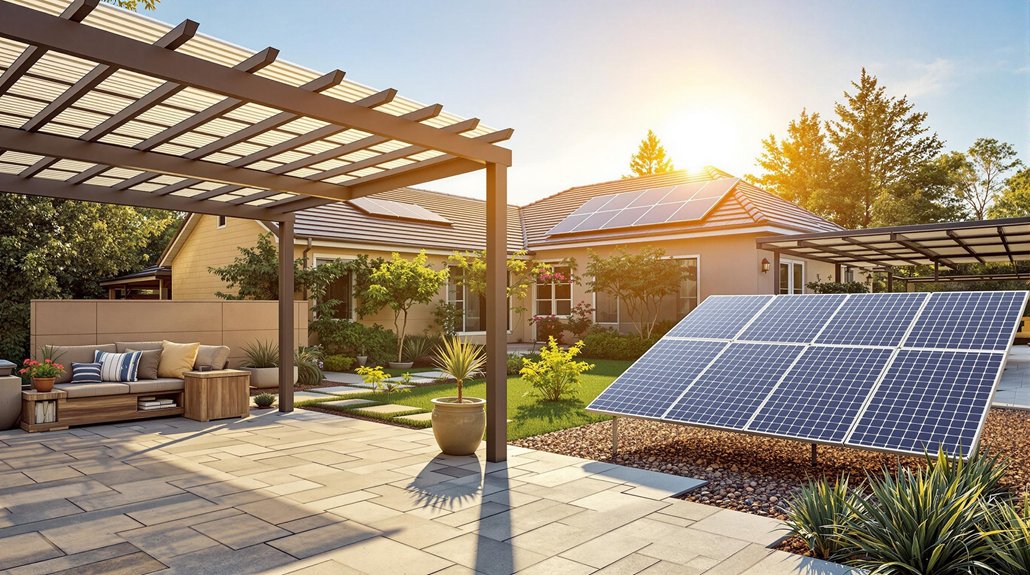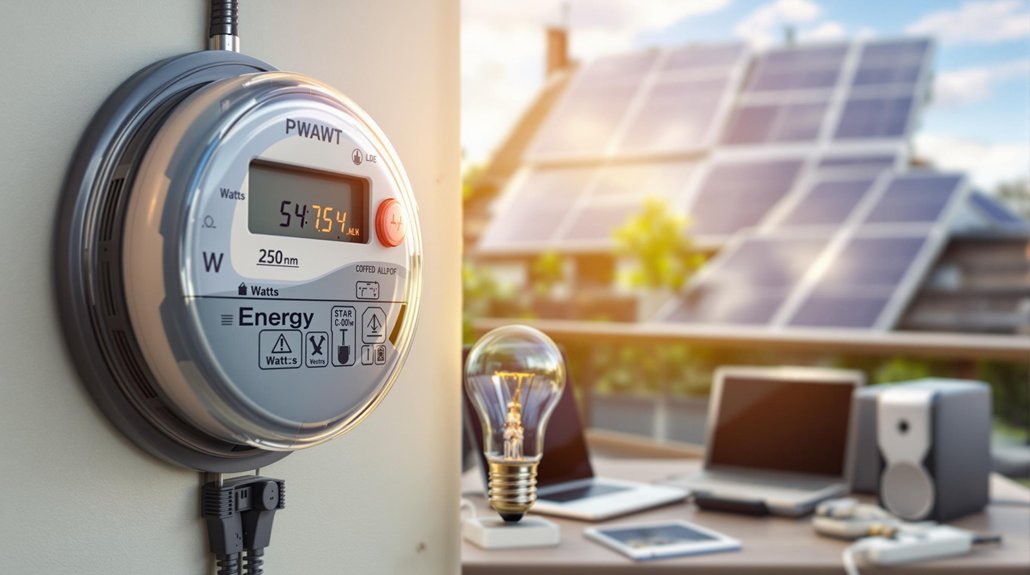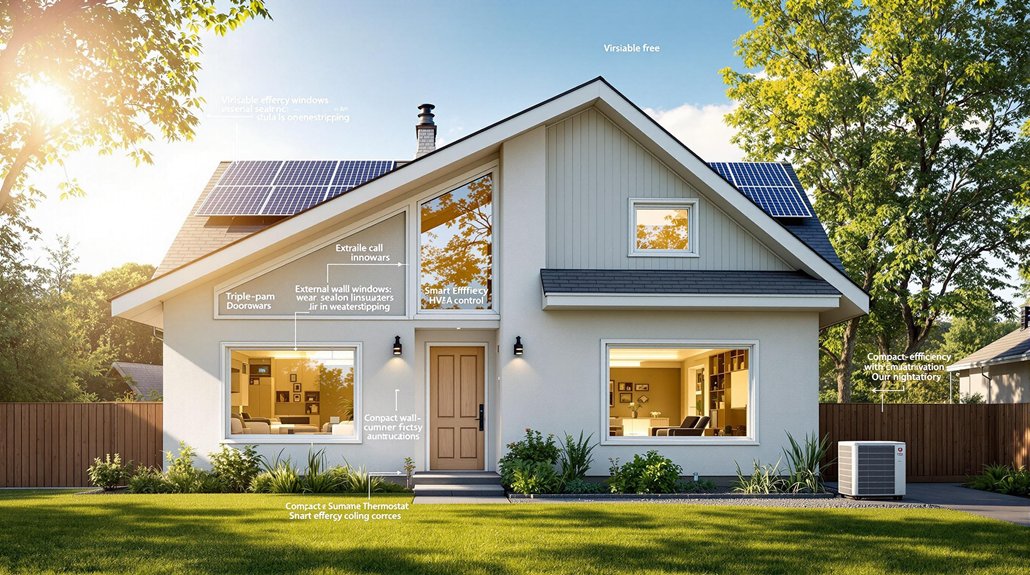Beyond traditional rooftop installations, homeowners have multiple creative options for mounting solar panels. Ground-mounted arrays offer easy maintenance access and ideal positioning. Solar pergolas and canopies provide shade while generating electricity for patios or walkways. Solar carports protect vehicles while powering homes. Building-integrated photovoltaics like solar tiles blend seamlessly with architecture. These alternatives can maximize energy production while enhancing a property’s functionality and visual appeal. More innovative mounting solutions continue to emerge.

When homeowners decide to install solar panels, they often don’t realize the variety of mounting options available. The most common choice for residential installations is rooftop mounting. This method requires a structurally sound roof with proper orientation. Panels are typically angled between 30-40 degrees to capture ideal sunlight. Special racking systems attach to roof rafters or trusses, and they can be installed on various roof types including asphalt shingle, metal, or tile. Many homeowners choose lightweight aluminum mounting materials for their durability and corrosion resistance.
For properties with plenty of open space, ground-mounted arrays offer an excellent alternative. These systems are installed 3-4 feet above the ground to allow for snow clearance. They use concrete footings or driven posts for stability. Ground mounts provide easier access for maintenance and cleaning, and allow for precise positioning to maximize energy production. Some ground-mounted panels feature adjustable kickstands for optimizing the angle based on seasonal sun positions. These installations can significantly reduce carbon emissions while providing reliable electricity to homes and businesses.
Solar pergolas and canopies serve dual purposes by generating electricity while providing shade. They can be installed over patios, parking areas, or walkways. These structures add visual appeal while making efficient use of available space. Both homes and businesses can benefit from these dual-function installations.
Solar carports offer another creative solution, combining vehicle protection with energy generation. A typical carport can cover 4-6 parking spaces. Many businesses and multi-unit residences install these structures, sometimes adding electric vehicle charging stations beneath them.
For a more integrated approach, Building-Integrated Photovoltaics (BIPV) incorporate solar cells directly into building materials. Options include solar roof tiles, facades, and windows that blend seamlessly with architectural designs. While more expensive than traditional panels, they offer improved aesthetics.
Pole mounts work well for small arrays or off-grid applications. Each pole typically supports 2-8 panels and allows for easy adjustment of angle and orientation. They’re often used in remote locations for power systems or water pumping operations.
The newest trend is floating solar arrays installed on bodies of water. These systems reduce water evaporation, inhibit algae growth, and benefit from cooler temperatures that improve efficiency.
Frequently Asked Questions
How Much Weight Will My Roof Need to Support?
A typical roof will need to support 20-30 pounds per square foot for solar panel installation.
This includes 2-4 pounds per square foot for the panels themselves, plus 3-5 pounds for mounting hardware.
A standard residential system with 20 panels could add 800-1,000 pounds total.
Snow loads, wind forces, and the roof’s current condition all affect this calculation.
Can I Install Solar Panels Myself or Need Professionals?
DIY solar installation is possible for small systems under 2 kW but requires electrical and construction knowledge. Homeowners can save 10-30% on costs, but many manufacturers’ warranties are voided without professional installation.
Professionals handle permits, design, and utility paperwork while completing work faster (1-3 days). Experts recommend professional installation for grid-tied systems over 5 kW, complex roof layouts, or when financing options are needed.
What Permits Are Required for Unconventional Solar Panel Installations?
Unconventional solar installations typically require several permits.
Building permits guarantee structural safety for unusual mounting systems.
Electrical permits verify proper wiring connections regardless of installation type.
Zoning permits address land use concerns, especially for unique ground installations.
Special permits may be needed in historic districts or from homeowners’ associations.
Coastal areas often require environmental impact assessments.
Fire department approval guarantees emergency access remains viable with non-standard configurations.
How Do I Clean Solar Panels in Hard-To-Reach Mounting Positions?
Cleaning hard-to-reach solar panels requires specialized tools or professional help.
Homeowners can use telescopic poles with soft brushes that extend up to 30 feet. Deionized water systems that don’t leave residue are effective.
For extremely difficult positions, robotic cleaners provide a hands-off solution. Many property owners hire certified professionals who have safety equipment and training.
These services typically cost $100-$300 per cleaning.
Will Unusual Mounting Affect My Home Insurance Coverage?
Unusual solar panel mounting can affect home insurance coverage.
Standard roof mounts typically fall under dwelling coverage, while ground-mounted panels are often covered under “other structures.”
Unique installations may require special endorsements or riders. Insurers might demand professional installation documentation for non-standard mounts.
Homeowners should notify their insurance company before installation. Some mounting types could void standard policy coverage.
Separate solar panel insurance is available if needed.









